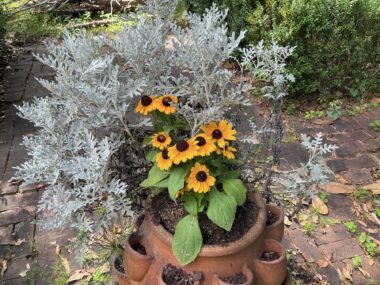I find solace in the benefits of gardening and warm weather
Sunshine eases my CAD symptoms, and flowers improve my mental health

Summer is my all-time favorite season and always has been. I’ve been a dreamer all my life, and my favorite pastime when I was younger was to take a book outside, find a place in the woods or beneath a bush and read. I’d watch fluffy, cumulus clouds meander through deep, blue skies and feast my eyes on the brilliant, happy flowers that covered the gardens where I lived.
Those included huge sunflowers that grew taller than I was. Like me, they’d turn their faces toward the sun to soak in its warmth. They’d follow the sun’s path through the sky, resting during night’s darkness only to begin again the next morning.
Nowadays, I still spend a lot of time dreaming and imagining things. Like those sunflowers, I often sit outside and turn my face toward the warmth of the sun. I have a good excuse, though, because I have cold agglutinin disease (CAD), the symptoms of which are exacerbated by cold weather.
I spend a lot of time outdoors among the flowers, both managing the blooms and trying to maintain my quality of life. To do that, I must take several things into consideration.
Managing CAD
For me, summertime and being outdoors are healthy ways of managing CAD symptoms that happen in colder temperatures, such as fatigue, anemia, and acrocyanosis, the mottled coloration of my fingers and toes.
In addition to physical benefits, enjoying gardens and the great outdoors when it’s warm out improves my mental health. Sunflowers, daisies, rudbeckia, and other flowers are often seen as symbols of happiness, positivity, and vitality. This is a good remedy for the depression that about 60% of us “CADdies,” as we call ourselves, experience.

Rudbeckia, dusty miller, and a squirrel-planted pine tree in a strawberry planter make columnist Mary Lott smile. (Photo by Mary Lott)
Additionally, low-energy activities like weeding, removing spent blooms, and watering the plants provide gentle movement for oxygen-starved muscles. I can work in spurts and then frequently relax in the beauty of my surroundings, taking joy from the beautiful space I’ve created.
Growing sunflowers and other plants suits me well. What I’ll often do is ask someone to dig a hole for me, and then I’ll plunk the greenery into the ground. I’ll scrape some dirt back around the stems, toss some Epsom salt on the dirt, and water it well. Easy-peasy!
Another benefit to maintaining a garden: It interrupts the isolation CAD imposes on me. With gardening, other people are always involved, such as neighbors and friends who give me advice and share blooms and cuttings. Best of all, having a beautiful garden is a nice setting for sipping tea and enjoying the fireflies flitting about at sunset. I find it to be peaceful, relaxing, and tranquil.
Managing CAD isn’t easy, however. I must constantly be aware of the ambient temperatures and the exertion a particular activity requires. For example, the weather was in the upper 80s when I arrived at church the other day, which was fine. But walking across the parking lot left me gasping for air as I sunk into a pew. Even in the summertime, I must make adjustments to manage CAD.
One important adaptation I must make is solving two dilemmas: When planning my blossoms in the spring, I must decide where I should put my giant sunflowers and other towering blooms, and more importantly, who I can cajole into doing the digging!
Note: Cold Agglutinin Disease News is strictly a news and information website about the disease. It does not provide medical advice, diagnosis, or treatment. This content is not intended to be a substitute for professional medical advice, diagnosis, or treatment. Always seek the advice of your physician or other qualified health provider with any questions you may have regarding a medical condition. Never disregard professional medical advice or delay in seeking it because of something you have read on this website. The opinions expressed in this column are not those of Cold Agglutinin Disease News or its parent company, Bionews, and are intended to spark discussion about issues pertaining to cold agglutinin disease.






Leave a comment
Fill in the required fields to post. Your email address will not be published.